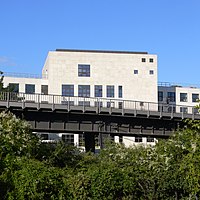Oswald Mathias Ungers
Oswald Mathias Ungers | |
|---|---|
| Born | 12 July 1926 Wallraf-Richartz Museum, Cologne |
Oswald Mathias Ungers (12 July 1926 – 30 September 2007) was a German architect and architectural theorist, known for his rationalist designs and the use of cubic forms. Among his notable projects are museums in Frankfurt, Hamburg and Cologne.
Biography
Oswald Mathias Ungers was born in
He was a professor at the Technical University of Berlin from 1963 to 1967 and served as the dean of the faculty of architecture from 1965 to 1967. In 1968 he moved to the United States, where he became the chair of the department of architecture at Cornell University from 1969 to 1975. In 1971 he became a member of the American Institute of Architects. He was also a visiting professor at Harvard University (1973 and 1978) and the University of California, Los Angeles (1974/75). He returned to Germany in 1976, becoming a visiting professor at the University of Applied Arts Vienna (1979/80) and a full professor at the Kunstakademie Düsseldorf (1986).
Ungers died on 30 September 2007 from pneumonia.[1] He was married to Liselotte Gabler (1926–2010) and had one son, the architect Simon Ungers, and two daughters.[2]
On his work
Ungers' buildings are characterized by strict
Well-known students of Ungers include Max Dudler, Jo. Franzke, Hans Kollhoff, Rem Koolhaas, Christoph Mäckler, Jürgen Sawade and Eun Young Yi.[2]
The Archive for Architectural Research (UAA)
Ungers Archive for Architectural Research contains his architecture library, which he began building in the 1950s, as well as the architect's entire artistic legacy.
Ungers' collection of architectural icons
Part of the Ungers Archive for architectural Research are the models of historical
- 1993: Parthenon,[6] Athens, 447–438 BC, model in scale 1:50
- 1995: Pantheon Rom,[6] 118–128 BC, model in scale 1:50
- 2001: Castel del Monte by Friedrich II,[6] Apulia, 1240–1250, model in scale 1:70
- 2002: Kenotaph for Isaac Newton,[6] 1784, Architect: Étienne-Louis Boullée, model in 1:400 scale
- 2001: Tiempietto del Bramante,[6] Rome, 1502, Architect: Donato Bramante, model in scale 1:15
- 2004: , circa 520 AD, model in scale 1:20
Selected projects
- 1958–1959 Haus Ungers in Lindenthal, Cologne[7]
- 1979–1984 German Architecture Museum in Frankfurt[8]
- 1980–1983 Messe Torhaus in Frankfurt[9]
- 1981–1984 Konstantinplatz in Trier[10]
- 1983–1991 Baden State Library in Karlsruhe[11]
- 1986 Former main building of the Alfred Wegener Institute for Polar and Marine Research in Bremerhaven[12]
- 1993–1996 Friedrichstadt-Passagen (Quartier 205) in Berlin[13]
- 1994 Residence of the German ambassador in Washington D.C.[14]
- 1994–1995 Haus ohne Eigenschaften (house without qualities) in Cologne[15]
- 1995 Hamburger Kunsthalle, Galerie der Gegenwart[16]
- 1998–2001 Dorotheenhöfe, Berlin[17]
- 2001 Wallraf-Richartz Museum in Cologne[18]
- 2006 Entrance to the ruins of a Roman bath in Trier[19]
- Proposed or under construction
- In 2000, he won an architectural competition to redesign the Pergamon Museum in Berlin.[20] His controversial plan proposes large alterations to the building complex which has remained unchanged since 1930. The rebuilding is scheduled to end in 2025.[21]
Gallery
-
Hamburger Kunsthalle, Galerie der Gegenwart
-
Messe Torhaus in Frankfurt
-
Badische Landesbibliothekin Karlsruhe
-
Wallraf-Richartz Museumin Cologne
-
Alfred Wegener Institute for Polar and Marine Research in Bremerhaven
-
German Architecture Museum in Frankfurt
-
Domestic relations court in Berlin-Kreuzberg
Awards
- 1987 Großer BDA Preis[22]
- 1997 Commander's Cross of the Order of Merit of the Federal Republic of Germany[2]
Writings
- Ungers, Oswald Mathias (2011). City metaphors (in German). Köln: Walther Konig Verlag. ISBN 978-3-86560-946-5.
- —— (2011). Die Thematisierung der Architektur (in German). Sulgen: Niggli. ISBN 978-3-7212-0698-2.
- —— (1999). Was ich immer schon sagen wollte über die Stadt, wie man sich seine eigenen Häuser baut, und was andere über mich denken: Aphorismen zum Häuserbauen (in German). Wiesbaden Braunschweig: Vieweg. ISBN 978-3-528-08143-0.
- ——; Neumeyer, Fritz (1991). "Entwerfen mit Vorstellungsbildern, Metaphern und Analogien. Anmerkungen zu einem morphologischen Konzept". Architektur 1951 – 1990 (in German). Stuttgart: Dt. Verl.-anst. ISBN 978-3-421-03010-8.
References
- ^ "Kreativität im Quadrat: Architekt Oswald Ungers gestorben". Der Spiegel (in German). 4 October 2007. Retrieved 11 October 2023.
- ^ a b c Olbrych, Claudia. "Ungers, Oswald Mathias". Frankfurter Personenlexikon (in German). Retrieved 11 October 2023.
- FAZ.net. Retrieved 20 June 2019.
- ^ "The UAA". www.ungersarchiv.de. Retrieved 20 June 2019.
- ^ Zimmermann, Eva (October 2008). "Grimms Gipsmodelle". Architectural Digest. p. 68.
- ^ a b c d e f "Architekturikonen" [architectural icons]. www.ungersarchiv.de. Retrieved 20 June 2019.
- ^ "Wohnhaus des Architekten O.M. Ungers — Köln". Deutsche Stiftung Denkmalschutz (in German). Retrieved 11 October 2023.
- ^ "Portrait". DAM Online (in German). 8 August 2021. Retrieved 11 October 2023.
- ^ "Messehaus Torhaus 9". Frankfurt.de (in German). Retrieved 11 October 2023.
- ^ "Luther-Platz an der Basilika". Stadt Trier (in German). Retrieved 11 October 2023.
- ^ "BLB: Architekt". BLB (in German). Retrieved 11 October 2023.
- ^ "Architecture". AWI. Retrieved 11 October 2023.
- ^ "Friedrichstadt-Passagen". berlin.de (in German). 21 July 2023. Retrieved 11 October 2023.
- ISBN 978-3-7757-0556-1.
- ^ "Architekturführer Köln". Architekturführer Köln (in German). Retrieved 11 October 2023.
- ^ "Kunst der Gegenwart". Hamburger Kunsthalle (in German). Retrieved 11 October 2023.
- ISBN 978-3-936314-18-2.
- ^ "Streng geschichtet - Wallraf-Richartz-Museum von O. M. Ungers in Köln eröffnet". BauNetz (in German). 19 January 2001. Retrieved 11 October 2023.
- ^ "Thermen am Viehmarkt". Burgenlandschaft Pfalz (in German). Retrieved 11 October 2023.
- ^ "Pergamonmuseum". Stiftung Preußischer Kulturbesitz (in German). Retrieved 11 October 2023.
- FAZ.NET(in German). Retrieved 11 October 2023.
- ^ "Mit zeitlichem Abstand". BAUWELT (in German). 28 August 2023. Retrieved 18 November 2023.
External links
- "UAA". Ungers Archiv für Architekturwissenschaft (in German). Retrieved 11 October 2023.
- Pogrebin, Robin (6 October 2007). "Oswald M. Ungers, Design Theorist and Architect of Major German Projects, Dies at 81". The New York Times. Retrieved 11 October 2023.
- Glancey, Jonathan (18 October 2007). "Obituary: OM Ungers". The Guardian. Retrieved 11 October 2023.







